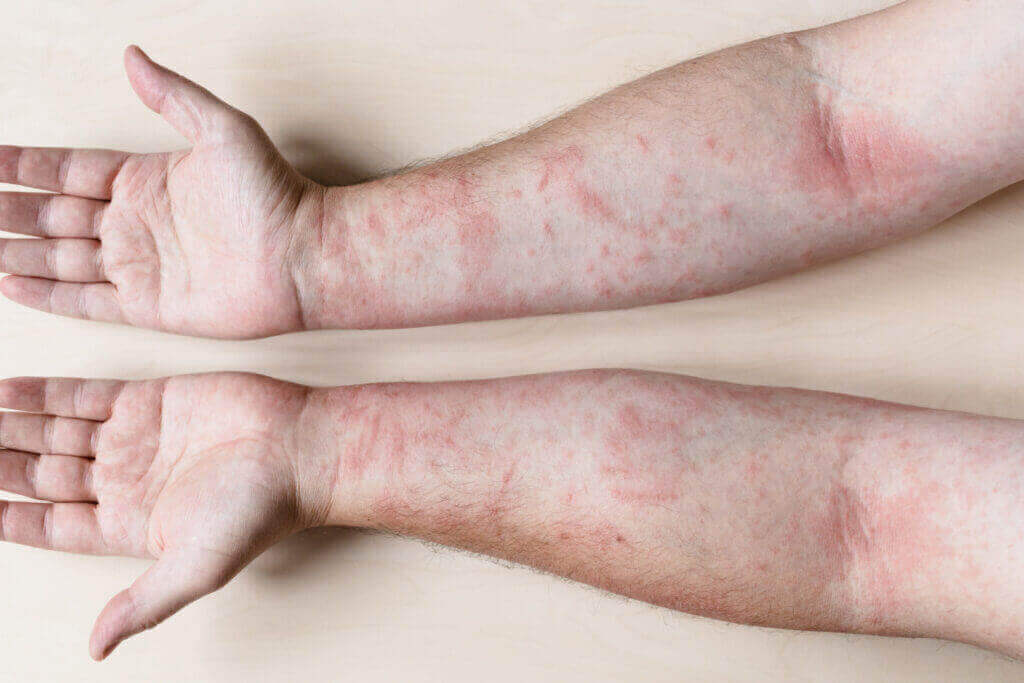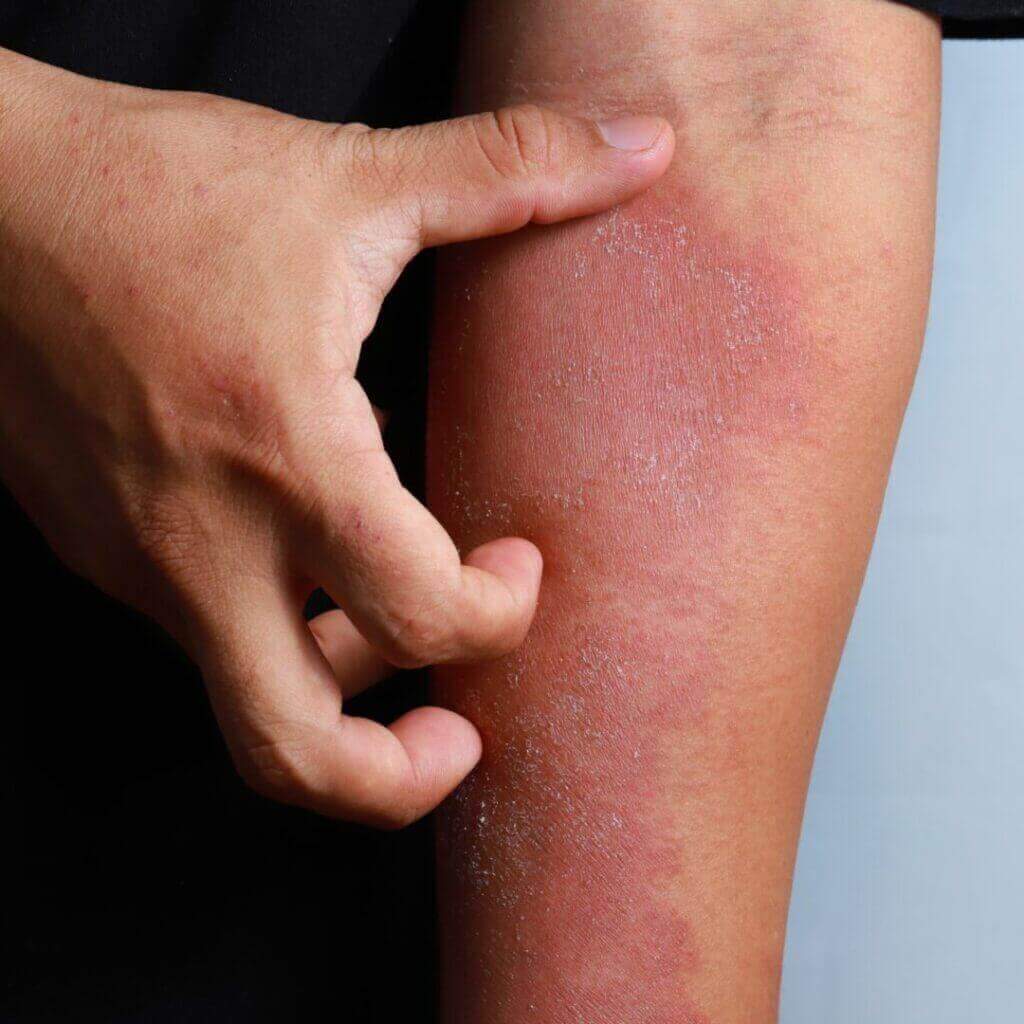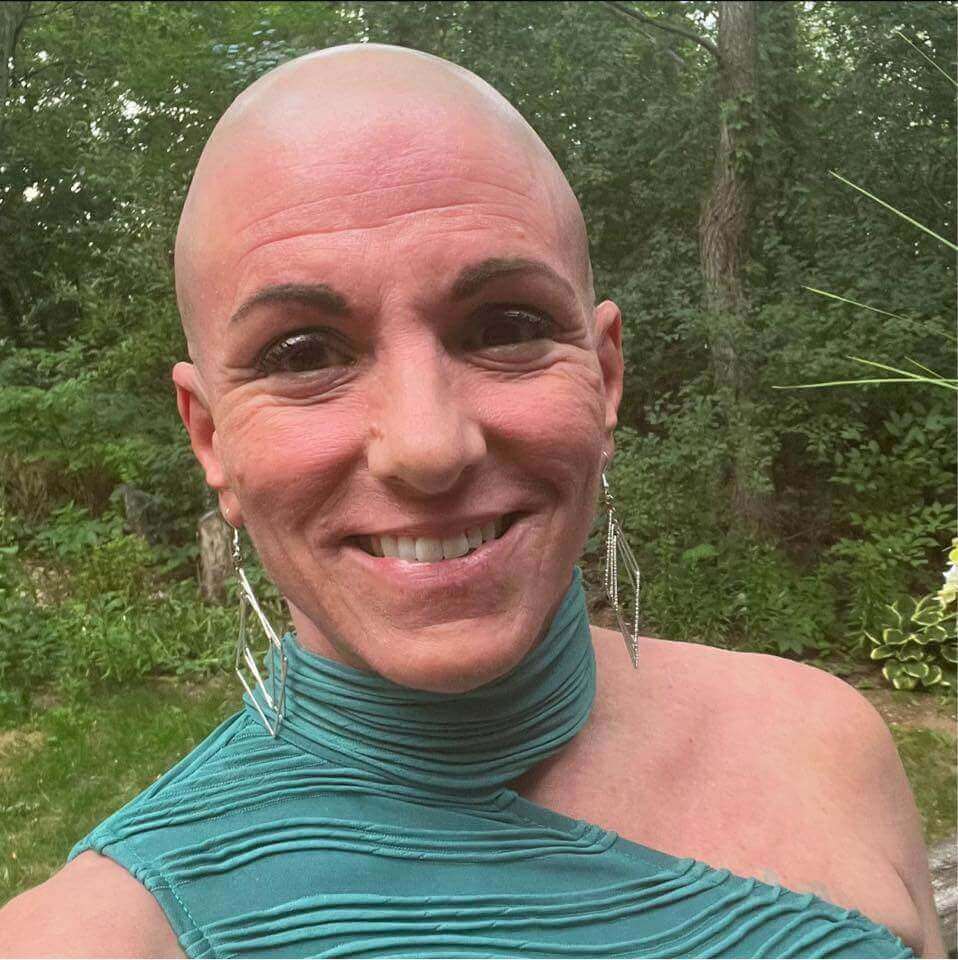
Topical Steroid Withdrawal, or TSW for short, is a skin condition that occurs from the use of medicines that contain topical steroids. These ingredients are typically referred to as topical corticosteroids or glucocorticosteroids. A very common topical steroid that you may have heard of is cortisone.

According to the National Eczema Association,
“Topical Steroid Withdrawal (TSW), also known as Topical Steroid Addiction (TSA) or Red Skin Syndrome (RSS), is a potentially debilitating condition that can arise from the use of topical steroids to treat a skin problem, such as eczema.”
While TSW is sometimes used interchangeably, there are a few differences between TSA, RSS, and TSW. Let’s explore.
Tachyphylaxis is a medical term that references when a patient becomes tolerant to the therapeutic benefits of a specific therapy, in this case, topical steroids, and when more of the drug is required in order to achieve the same previous levels of benefit. TSA occurs when a patient’s body no longer receives the same level of benefit that it previously did from the use of topical steroids and when there are “well-defined physiological symptoms upon withdrawal.”
Red Skin Syndrome (RSS) is sometimes also referred to as Red Burning Skin Syndrome (RBSS) and refers to the steroid withdrawal symptom that occurs, causing vasodilation of capillaries in the skin when steroid use is ceased. This symptom is characterized by inflamed skin and a full body rush of painful stinging and burning.
The International Topical Steroid Awareness Network, also known as ITSAN, is a nonprofit that is leading the mission to support those suffering from TSW, as well as helping to raise awareness surrounding this syndrome. On their website, they explain TSW very well.
“Withdrawal,” in reference to medication, is defined as a group of symptoms that occur after stopping or reducing intake of a drug. “Topical Steroid Withdrawal Syndrome” refers to the symptoms that occur when someone ceases topical steroid use, reduces potency, applies topical steroids to fewer areas of the body, or applies them less often. Weaning, stepping down or ceasing use can all cause varying degrees of withdrawal symptoms. The cluster of shared symptoms during withdrawal is why TSW Syndrome is known as a “syndrome.”

Topical steroids are utilized to treat a wide variety of different skin conditions, including eczema, psoriasis, papulopustular, and others. Unfortunately, researchers and medical professionals do not fully understand the underlying triggers that cause these often severely debilitating symptoms to occur when the use of topical steroids stops or topical steroids stop working. Because of this, the only truly efficient way to prevent TSW is to avoid the use of topical steroids on the skin altogether. Like the underlying trigger for TSW, its prevalence is also unclear.
“TSW Syndrome is an iatrogenic condition, which means it is a condition caused inadvertently by a medical treatment. Not everyone who uses topical steroids will develop TSWS. It is unclear why some individuals experience TSWS secondary to topical steroid therapy and why others do not.” – ITSAN
When it comes to signs and symptoms of TSW, there are two categories to be aware of, and those are symptoms that occur prior to stopping the use of topical steroids and those that occur when discontinuing them for any amount of time.

The only true way to prevent TSW is to not utilize topical steroids. Thankfully, there are many ways to treat skin conditions that topical steroids are commonly utilized for that do not include these potentially dangerous ingredients or the risk of developing TSW. That means that, in essence, this condition is 100% preventable. This documentary, “Preventable: Protecting Our Body’s Largest Organ,” by ITSAN member Briana Banos, explores many aspects of TSW, including the hell that many TSW Syndrome sufferers endure. As ITSAN explains, there isn’t a treatment or cure for TSW, and aside from discontinuing topical steroid use, patients and doctors can only address the management of associated symptoms.
So, what other options are there for treating various skin conditions that topical steroids are commonly prescribed and utilized for? Let’s explore!

To understand the many things that can take the place of topical steroids, it is first important to understand exactly what their function is within topical creams, ointments, gels, foams, lotions, and more. The main purpose of topical steroids is to reduce inflammation. They do so through various avenues. This includes blocking chemical reactions that cause inflammation by blocking the production of arachidonic acid by triggering the body to produce lipocortin proteins. Steroids also dampen the immune system’s ability to release toxins in the body that add to inflammation. Additionally, topical steroids constrict blood vessels and capillaries to reduce localized pain and swelling which can lead to inflammation.
Now that we have a better understanding of the purpose of topical steroids let’s explore a few of the alternatives to reducing the underlying inflammation that causes various skin and internal conditions, including eczema, psoriasis, and many others in which topical steroids are commonly prescribed. There are a plethora of medicinal plants, herbs, and flowers that have been shown to offer anti-inflammatory properties. A few of these are curcumin, calendula, and chamomile.
Curcumin, an active compound found in turmeric, is a powerful anti-inflammatory that has been shown in studies to reduce “skin psoriasis-like inflammation” and has been found to be “a suitable candidate for treating skin conditions that are characterized by derangement of the inflammatory response.”
Calendula, commonly known as pot marigold, has been found through studies to offer anti-inflammatory properties. This plant, which is widely found in Europe, Asia, and the United States, is in the same family as daisies and has been utilized for many centuries for various purposes in Ayurvedic medicines.
Chamomile is a very popular medicinal herb that offers amazing benefits for our overall health, both inside and out. When used topically, it has been shown to offer anti-inflammatory, antioxidant, and antimicrobial properties.

You can read information, you can read statistics, you can even see pictures of the individuals with TSW before and after, but nothing quite drives home the severity of this condition and just how much of a living hell it truly is like hearing the testimonials of those that have lived through or are currently facing it head on.
In a self-authored article on TheGuardian.com, Abigail Lowe stated the following regarding her journey.
“I started experiencing TSW in June 2021. Within a week of stopping the use of topical steroids, my entire body was ablaze. In the shower, my knees would buckle in pain because the water felt like acid. I shed skin like a snake. I couldn’t walk properly, dress myself or sleep. Half my hair fell out and I lost a lot of weight. After a month of this, I was forced to return home to my mum’s because I couldn’t look after myself. Within two days, she whisked me to A&E. My head-to-toe red skin (bar my hands) was now closer to purple and I couldn’t stop violently shaking. I spent the next week in hospital, where I was treated with a long course of oral steroids, a suggestion I was too unwell to refuse. Back at my mum’s, I contemplated whether I wanted to keep living. With the possibility that it could take years to recover hanging over me, the enormity of what lay ahead seemed too huge to overcome.”
Ceci French recounts the moment things started to change with her skin issues in an article published by the National Eczema Association stating the following.
“On February 14, 2021, my flares started changing. The sensation felt different than my previous skin rashes. I remember the burning and spreading of the fiery rash all over parts of my body that my eczema had previously never affected. It felt like my body was turning itself inside out.“
On May 3rd of this year, a dear friend of mine, Renata Feiner, posted to her Facebook page stating the following.
“I am now 2,313 days (6 years, 5 months and counting) into Topical Steroid Withdrawal and it’s been 3,044 days (8 years, 5 months and counting) since the Topical Steroid Addiction symptoms started. This is NO joke. TSW literally steals your life away with no notice. Although I have had some relief, I still struggle daily with my skin and crazy nerve pain. I’ve been fighting hives for the past several days. And the itch never. goes. away. This condition is especially maddening because it is 100% #Preventable.”
In an article published by USA Today in August 2023, Michelle Sansiveri’s journey with TSW was featured, with her stating the following in regard.
“The first six months were the hardest. I was glued to the couch or my bed. I didn’t want to go outside. I couldn’t show my face.”
The article also states that she suffered from bruises head to toe, and half of her fell out. These are just a few of the testimonials you can find online that tell of months and even years of intolerable itching, pain, burning, depression, and more endured by TSW sufferers.
You can view images and read the testimonials and stories of others with TSW here.
While there is no cure or approved treatment for TSW, there are ways that those suffering from this syndrome have found that help them to better cope with all of the ups and downs that it entails.
There are many ways that Cannabidiol, or CBD for short, could be greatly beneficial to those living with TSW. Both topical and ingestible CBD products have been shown to offer anti-inflammatory, antioxidant, antibacterial, antimicrobial, and various other beneficial properties. Additionally, when taken internally, CBD has also been shown to offer hope for those with anxiety, depression, and even insomnia, all issues that many of those going through topical steroid withdrawal experience. TSW Sufferer Renata Feiner posted to social media in 2019 that CBD had been a pure blessing.

“CBD has been life altering for me. Due to Topical Steroid Withdrawal (I am in Month 26 of Withdrawal), which has been likened to heroin withdrawal, but lasts anywhere from 1-8 years, I have fought insomnia, anxiety, panic attacks, absolutely debilitating pain and massive depression. CBD lessened it or taken away all of the above to the point that I was able to start participating in life again. Praise Jesus!” -Renata Feiner
You can find a complete “Survival Guide” on the ITSAN website here.